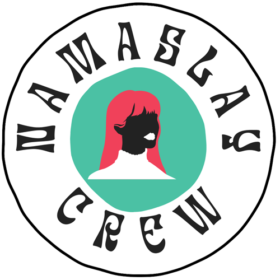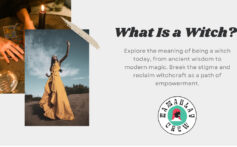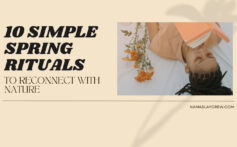A Comprehensive Guide to Divination Tools
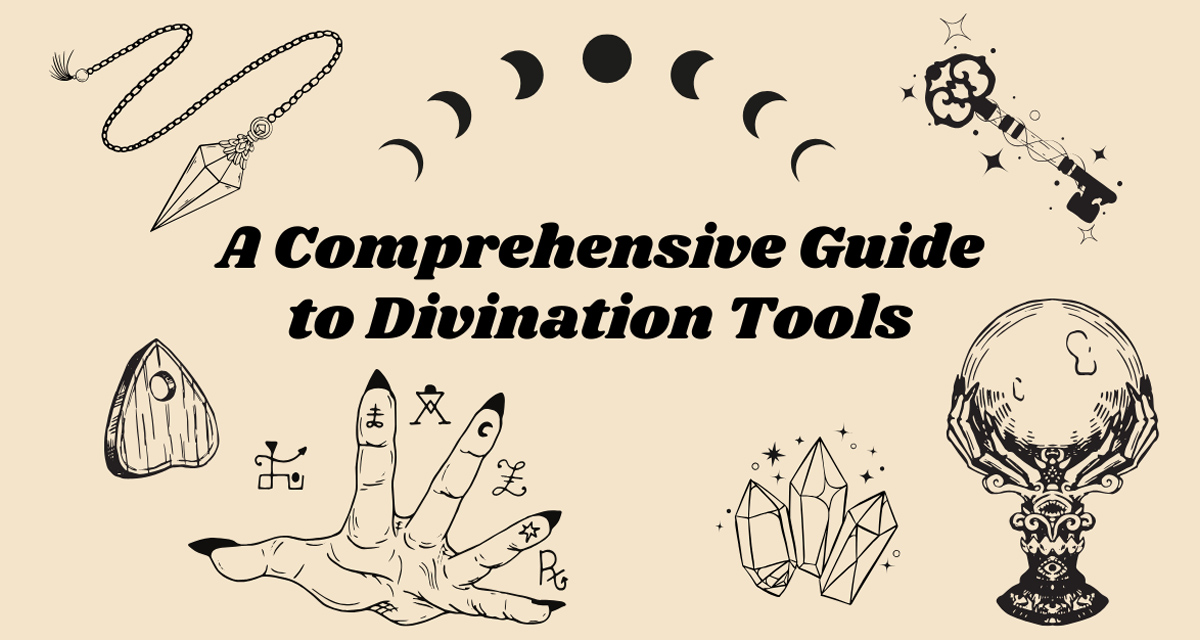
A Comprehensive Guide to Divination Tools
Disclaimer: Some links on this page are affiliate links. We may receive a commission if you make a purchase through these links. See our full disclaimer here.
Divination tools have captivated humanity for centuries, acting as a bridge between the seen and unseen. Whether seeking answers, clarity, or connection to something greater, these tools have been used across cultures as a way to explore life’s mysteries.
From ancient civilizations interpreting celestial patterns to modern seekers drawing a single tarot card, divination tools continue to offer profound insights for those ready to explore their depths. But what exactly are these tools, and how can they help unlock the secrets within and beyond?
What Are Divination Tools?
Divination tools are gateways to understanding the unseen forces that shape our lives. These mystical instruments have been used for centuries to provide clarity, offer guidance, and help individuals connect with their intuition. But let’s clear something up—divination isn’t about predicting the future with absolute certainty. Instead, it’s a way to interpret energies, uncover hidden truths, and navigate the present moment with more insight.
At their core, divination tools are symbols or methods that allow us to tap into our subconscious mind and the collective energy around us. They work by combining intuition, interpretation, and universal archetypes, making them as much about self-discovery as they are about connection to the greater cosmos.
Common Divination Tools
Tarot Cards
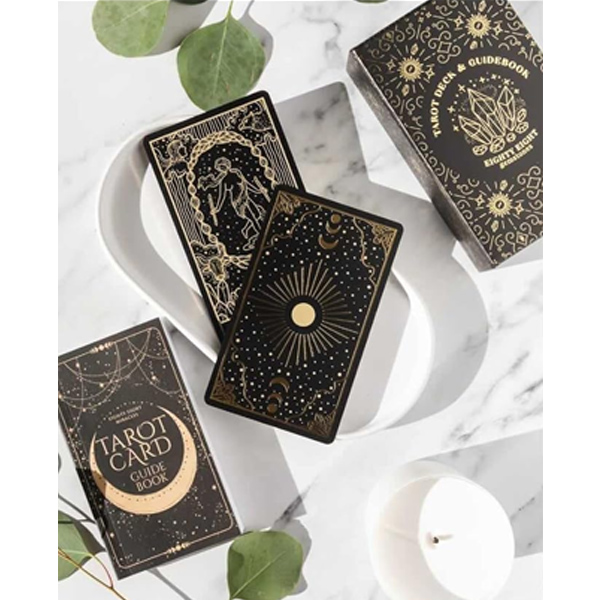
Decks of 78 cards, used to interpret past, present, and future situations.
Each card carries symbolic meanings that guide interpretation.
SHOP NOW
(at Amazon)
Runes
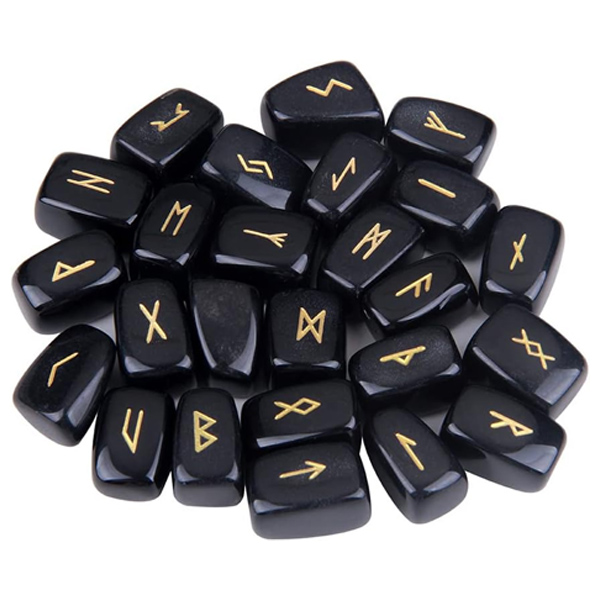
Ancient symbols carved into stones or wood, used to uncover insights or answers.
Each rune represents a specific concept or energy.
SHOP NOW
(at Amazon)
Crystal Balls
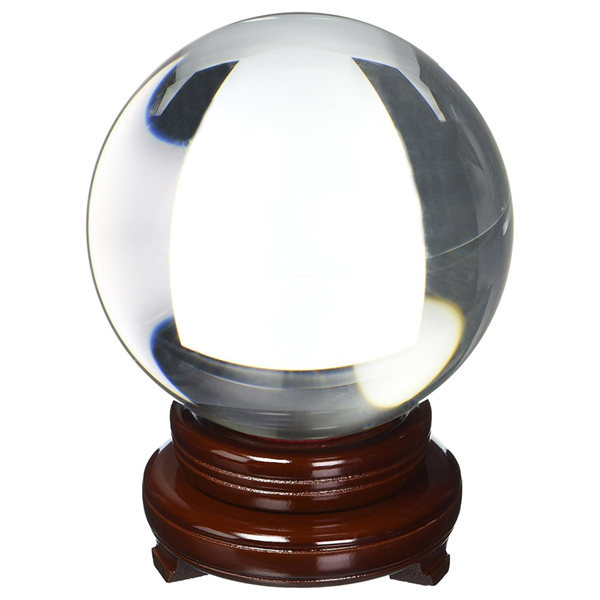
Scrying tools where one gazes into the ball to perceive images or visions.
SHOP NOW
(at Amazon)
Pendulums
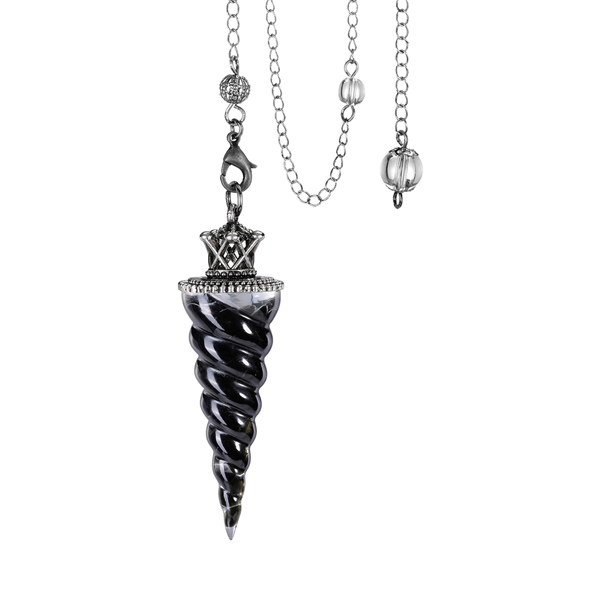
Weighted objects (often crystals) that swing in response to questions, offering “yes,” “no,” or directional guidance.
SHOP NOW
(at Amazon)
Astrology
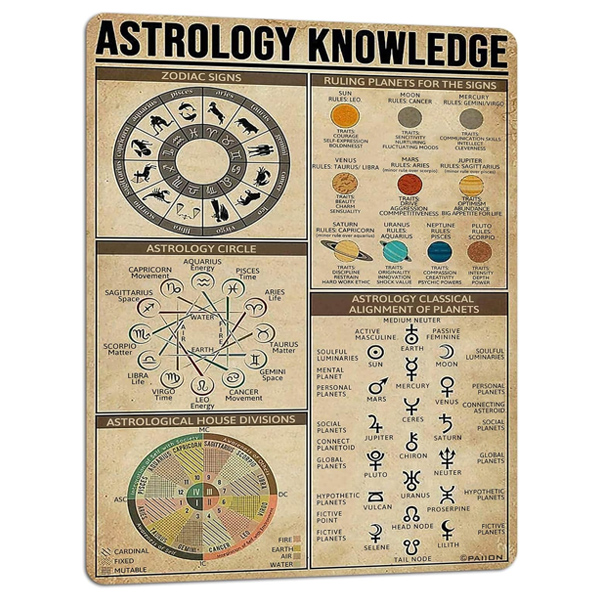
The study of celestial bodies (planets, stars, etc.) to understand their influence on human life and the world.
SHOP NOW
(at Amazon)
Numerology
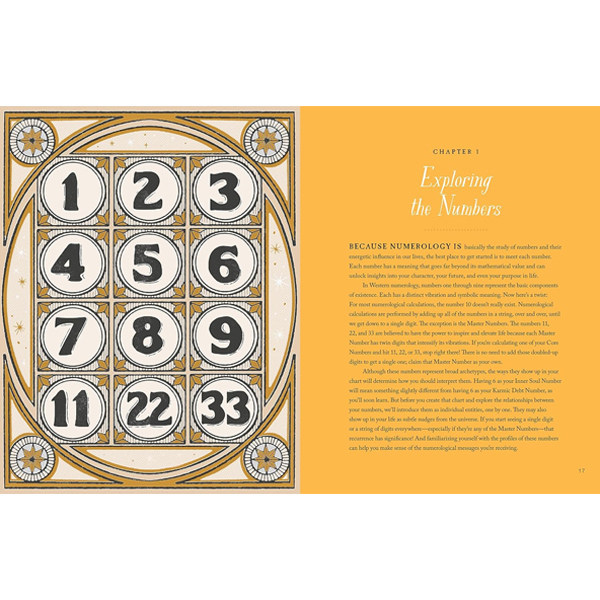
The interpretation of numbers and their vibrational meanings, often derived from names and birth dates.
SHOP NOW
(at Amazon)
I Ching
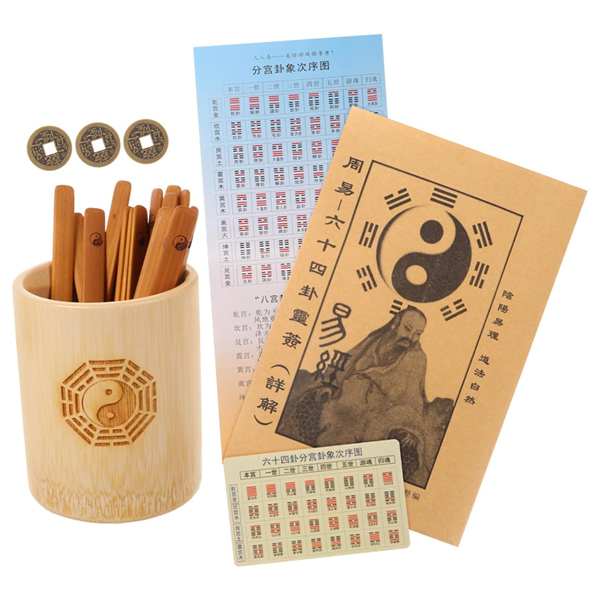
An ancient Chinese divination system involving hexagrams to provide philosophical guidance.
SHOP NOW
(at Amazon)
Tea Leaf Reading
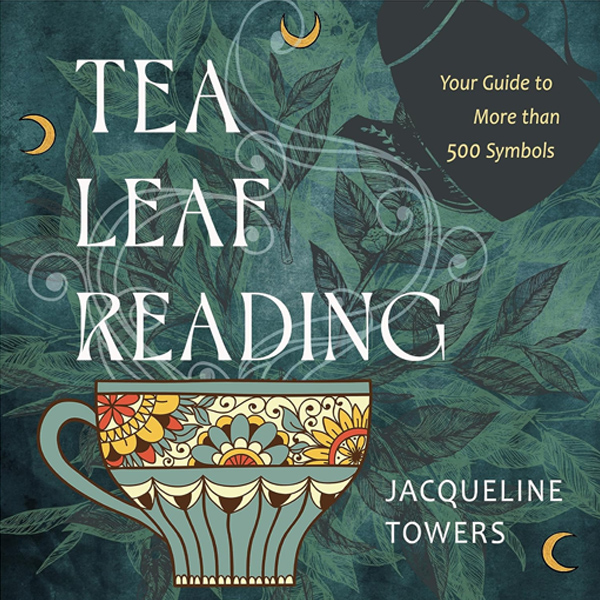
The interpretation of patterns left by tea leaves in a cup. (Tasseography)
SHOP NOW
(at Amazon)
Oracle Cards
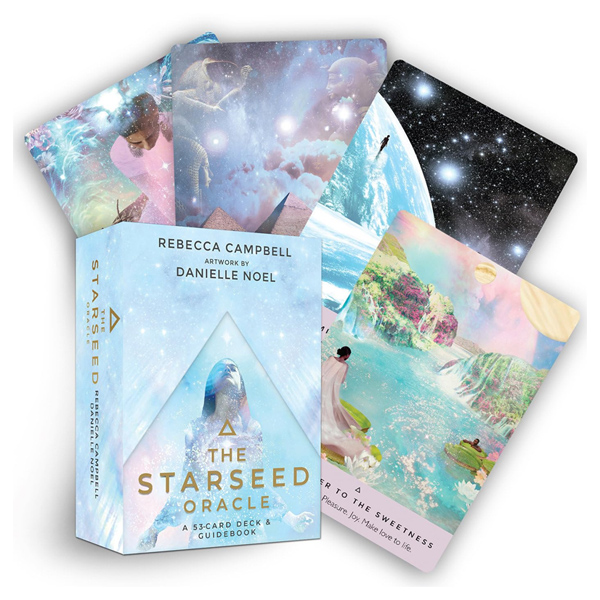
Similar to tarot but more varied in structure and themes, often offering uplifting or affirming messages.
SHOP NOW
(at Amazon)
Scrying Mirrors

Reflective surfaces (often black mirrors) used for meditative gazing to receive visions or impressions.
SHOP NOW
(at Amazon)
Palmistry
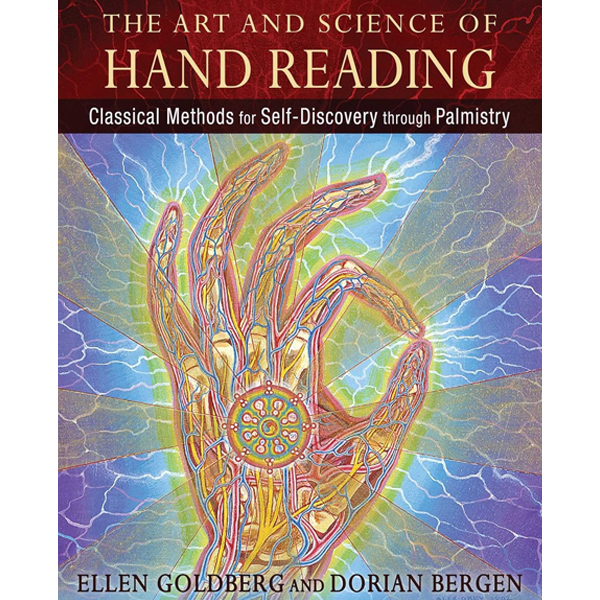
The reading of the lines and features of the hands to uncover personal traits or life patterns.
SHOP NOW
(at Amazon)
Dice or Lots

Objects like dice, bones, or small marked items cast to reveal answers through their positioning.
SHOP NOW
(at Amazon)
How They Work
Divination tools are believed to act as conduits for intuition, higher consciousness, or spiritual forces. They help bypass the logical mind, allowing symbolic or intuitive messages to surface. Often, the process relies on interpretation, which varies based on the user’s perspective, experience, and context.
Why Are Divination Tools So Popular?
From ancient civilizations to modern-day spiritual practices, these tools remain timeless. Why? Because they’re versatile and accessible. Whether you’re looking to gain insight into a tricky decision, explore your spiritual path, or simply reflect on your personal growth, divination tools meet you where you are.
For example:
- Tarot cards reveal the layers of energy surrounding your life circumstances.
- Runes offer direct, concise messages that cut straight to the heart of a matter.
- Astrology provides a cosmic roadmap for understanding personality, timing, and life’s ebb and flow.
By choosing the right tool, you can tailor the experience to your unique needs and intentions.
A Journey Through History: Divination Across Cultures
Divination has woven its way through the fabric of human history, transcending time and geography. For centuries, cultures around the world have sought guidance, wisdom, and clarity through practices that bridge the physical and spiritual realms. These ancient traditions remind us of the universal desire to seek answers beyond what we can see.
Ancient Egypt: The Mirror of the Gods
In the sands of Ancient Egypt, priests and seers turned to scrying bowls, filling them with water to glimpse divine visions. These shimmering reflections were believed to reveal messages from the gods, helping guide decisions about life, death, and the afterlife. Their belief in the interconnectedness of earthly actions and divine will laid the groundwork for many divinatory practices.
Chinese Culture: Wisdom in the I Ching
The I Ching, also known as the Book of Changes, dates back over 3,000 years and remains a cornerstone of Chinese philosophy. By casting coins or yarrow sticks to form hexagrams, practitioners interpreted universal energies and gained insights into life’s challenges. It’s a profound blend of logic, intuition, and cosmic flow.
Nordic Traditions: Runes of Fate
In Nordic culture, runes carved into wood or stone were not just letters—they were symbols of power and mystery. Each rune carried specific meanings and was often cast in patterns to interpret fate or seek guidance during uncertain times. To this day, runes are cherished for their ancient, straightforward wisdom.
Indigenous Practices: Nature’s Oracle
For Indigenous peoples across the globe, divination was deeply tied to nature. Bone casting, stones, and other natural objects were used by shamans to connect with spirits, offering insight into healing, hunting, or community challenges. These practices honor the sacred bond between humans and the natural world.
Mesoamerican Civilizations: Cosmic Calendars
In the heart of Mesoamerica, the Maya and Aztec civilizations looked to the stars. Their intricate astrological systems and calendars guided everything from planting seasons to ceremonial rituals. These tools were not only practical but also deeply spiritual, connecting the heavens with earthly life.
From scrying bowls to cosmic calendars, these practices share a common thread: a belief in the unseen forces shaping our lives. Today, modern divination tools often draw inspiration from these rich histories, allowing us to honor ancient traditions while adapting them to our own journeys.
Dive into the world of contemporary divination tools like tarot, pendulums, and oracle cards, and discover how they’re helping us find clarity in today’s complex world.
A Closer Look at Popular Divination Tools
In the world of divination, tools act as bridges between intuition and insight. Each one offers a unique way to explore the unknown, connect with deeper truths, and gain clarity. Let’s explore some of the most popular divination tools and how they work.
Tarot Cards
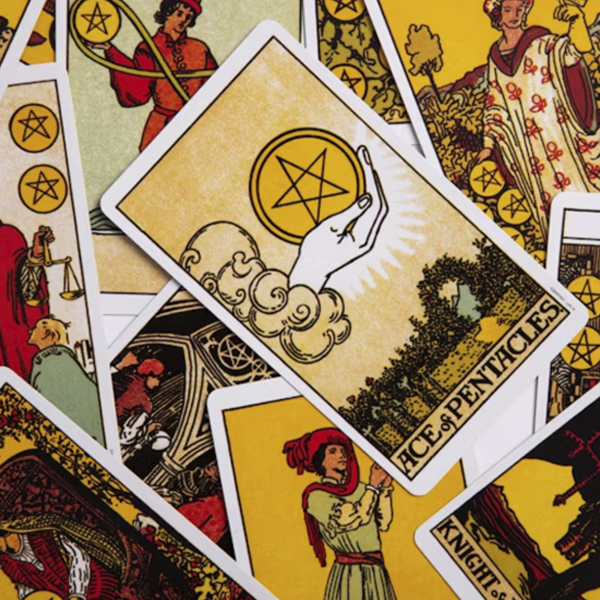
How They Work:
A tarot deck contains 78 cards, split into the Major Arcana (big life themes) and the Minor Arcana (day-to-day energies). Each card represents universal archetypes and energies, offering profound insight into life’s questions.
Purpose:
Tarot is often used for personal growth, decision-making, and spiritual guidance.
Popular Spread:
The three-card spread is a beginner-friendly favorite, offering insight into the past, present, and future of any situation. Try our FREE 3 Card Tarot Spread tool.
Fun Fact:
Modern tarot decks come in countless artistic styles, making them both a practical tool and a personal statement.
Runes
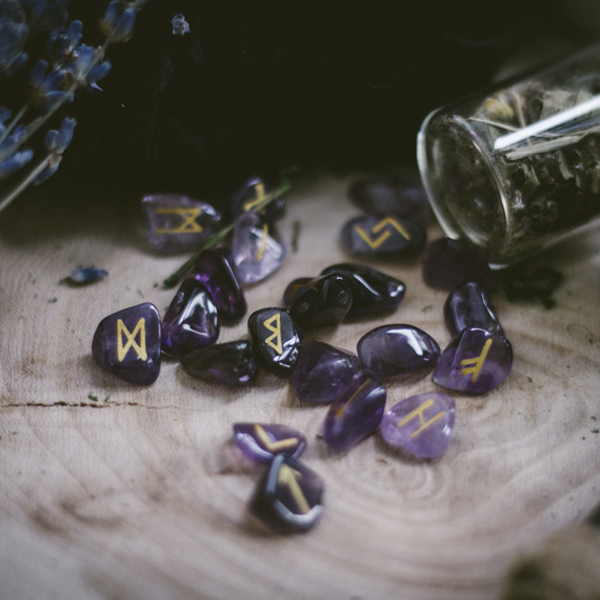
How They Work:
Runes are a set of symbols from ancient Norse culture, often carved into stones, wood, or even crystals. Casting the runes involves tossing or selecting them, then interpreting their meanings based on position and orientation.
Purpose:
Runes provide concise messages about challenges, decisions, and paths forward.
Unique Feature:
Their simplicity lies in their symbolism, making them a direct and powerful tool for clarity.
Modern Twist:
Many rune sets come with guidebooks, making them accessible even for beginners.
Pendulums
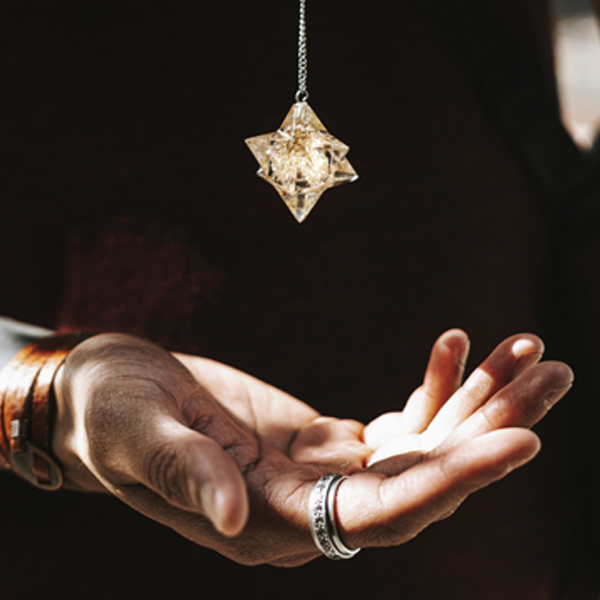
How They Work:
A pendulum—a weighted object, often a crystal or metal charm—swings in response to yes/no questions or to locate energies and objects.
Purpose:
Pendulums are excellent for binary questions or intuitive navigation.
Pro Tip:
Use a pendulum chart to expand its uses, like identifying chakras that need balancing or understanding energetic patterns.
Quick Note:
A pendulum’s accuracy depends on your focus and connection—clear your mind before starting.
Crystal Balls

How They Work:
Crystal balls are used for scrying, a practice of gazing into a reflective surface to see symbols, visions, or patterns.
Purpose:
Ideal for tapping into intuition and receiving visual insight.
Mystical Vibes:
Crystal balls are often paired with dim lighting or candlelight, creating a calming, meditative environment that enhances focus.
Did You Know?
Scrying isn’t limited to crystal balls—mirrors and even water surfaces can be used.
Astrology
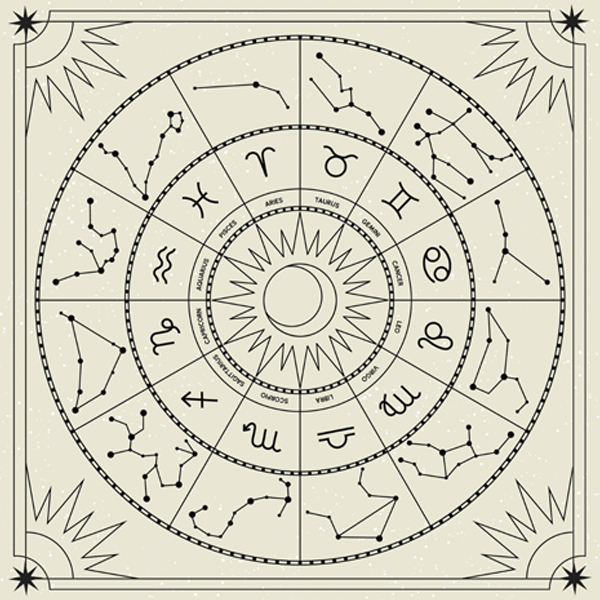
How It Works:
Astrology deciphers celestial alignments based on one’s natal chart, which maps the positions of the Sun, Moon, planets, and houses at the time of birth.
Purpose:
Astrology provides a roadmap to personality, timing, and life cycles, offering detailed guidance about strengths, challenges, and cosmic energies.
Unique Insight:
A natal chart goes beyond Sun signs to include Rising signs, Moon signs, and planetary aspects, giving a comprehensive view of your cosmic blueprint.
Pro Tip:
Free tools online can generate your chart, but a professional astrologer can add depth and nuance.
Oracle Cards
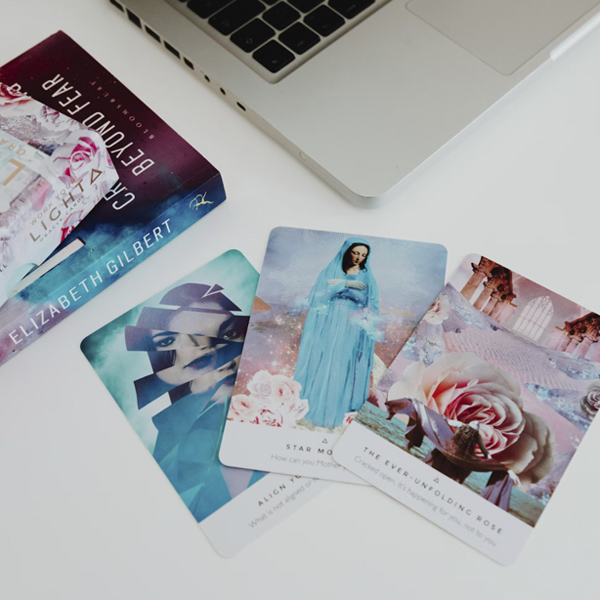
How They Work:
Oracle cards, like tarot, are drawn for guidance, but they’re typically more thematic and less structured, allowing for free-form interpretation.
Purpose:
Perfect for daily affirmations, broad themes, or gentle guidance without the structure of tarot spreads.
Flexibility:
You can pull a single card or a handful—it’s all about what feels right in the moment.
Tip for Beginners:
Choose a deck with artwork or themes that resonate with your personality or current journey.
How to Choose Your Divination Tool
Selecting a divination tool is an intimate and intuitive process, one that reflects your unique preferences, goals, and connection to spiritual practices. Here are some key factors to consider when choosing the tool that resonates most with you:
What Draws You?
Your intuition often knows best. Pay attention to what captures your imagination or feels naturally appealing.
- Crystals and Energy Work: If you’re drawn to the beauty and energy of crystals, a pendulum or crystal ball might feel like the perfect fit.
- Symbolism and Art: If you’re captivated by intricate designs and archetypes, tarot or oracle cards may align with your aesthetic and spiritual needs.
Tip: Visit a shop or browse images of tools online to see which ones spark a sense of curiosity or connection.
Your Goals
What do you want to achieve through divination? Different tools cater to different purposes.
- Detailed Guidance: Tarot or astrology can provide comprehensive insights into life’s complexities, making them ideal for deep exploration or long-term planning.
- Quick Clarity: If you’re looking for immediate answers, pendulums or runes offer straightforward guidance, especially for yes/no questions or short-term decisions.
- Visual Connection: Tools like crystal balls or scrying mirrors work well if you’re a highly visual person, helping you tap into symbolic imagery.
Pro Tip: Match your tool to your question. Use astrology for timing, tarot for detailed explorations, and pendulums for binary decisions.
Cultural Connection
Many divination tools are rooted in specific cultural or ancestral traditions, and connecting with those roots can enhance the depth of your practice.
- Ancestral Links: If you feel a strong connection to your heritage, explore tools that align with your background. For example:
- I Ching for East Asian traditions.
- Runes for Nordic ancestry.
- Bone casting for African or Indigenous practices.
- Universal Appeal: Don’t be afraid to explore tools outside your culture if they resonate deeply with you. Spiritual practices are often universal in their themes and wisdom.
Thoughtful Note: Respect and understand the origins of any divination tool you adopt, honoring the cultures and traditions they come from.
Finding Your Match
The right divination tool is the one that feels like an extension of your inner world. Experiment with different tools, start small and allow your preferences to evolve. Remember, the journey of divination is as much about self-discovery as it is about connecting with the universe’s wisdom.
How to Use Divination Tools Effectively
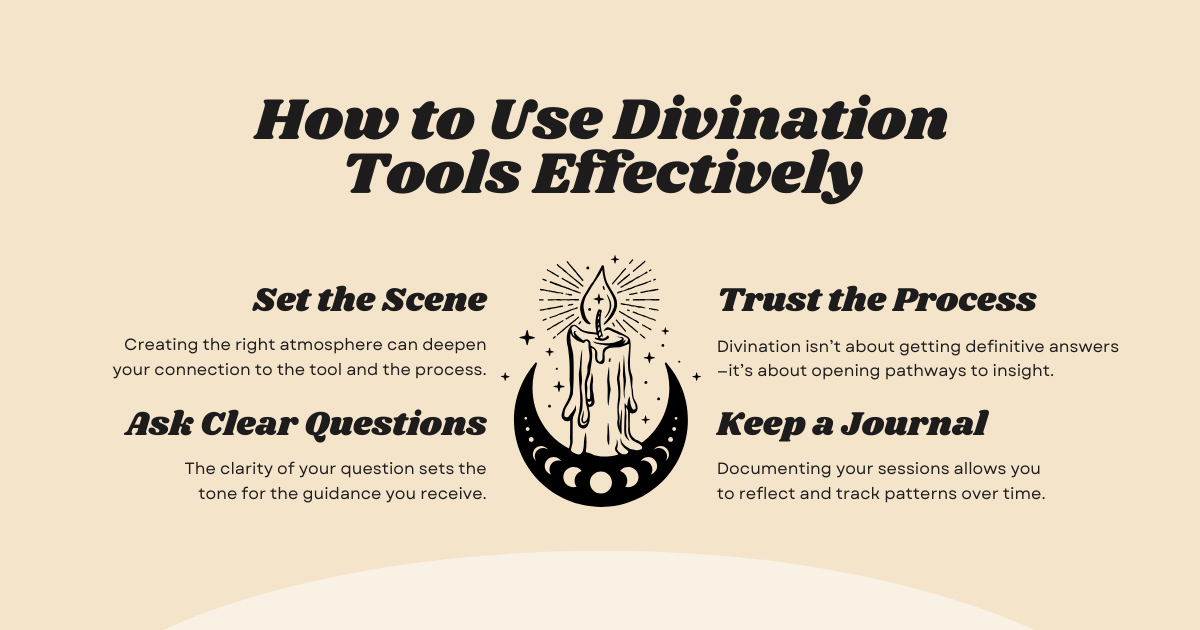
Divination is as much about the energy you bring to the practice as it is about the tools themselves. To get the most out of your divination sessions, follow these tips to create a meaningful and intuitive experience:
Set the Scene
Creating the right atmosphere can deepen your connection to the tool and the process.
- Sacred Space: Choose a quiet area where you can focus without distractions.
- Ambiance: Light candles, burn incense, or diffuse essential oils like lavender or sage to set a calming mood.
- Energetic Clearing: Cleanse your tools with methods like smudging, sound cleansing, or placing them under moonlight to remove any lingering energy.
Why It Matters: A sacred space helps you center yourself, enhancing the flow of intuition and insight.
Ask Clear Questions
The clarity of your question sets the tone for the guidance you receive.
- Be Specific: Instead of asking, “Will I be happy?” try, “What steps can I take to invite more joy into my life?”
- Open-Ended Questions: Allow room for interpretation. Tools like tarot and oracle cards are better suited for “How” and “Why”< questions rather than “Yes” or “No.”
- Yes/No Queries: Reserve these for pendulum use, where the answers are straightforward and direct.
Pro Tip: Write down your question beforehand to stay focused during the session.
Trust the Process
Divination isn’t about getting definitive answers—it’s about opening pathways to insight.
- Interpretation Over Absolutes: Understand that the messages are often symbolic, offering guidance rather than concrete predictions.
- Follow Your Intuition: Your initial feelings and interpretations matter as much as any traditional meanings associated with the tool.
Mindset: Approach divination with curiosity and openness rather than expecting certainty.
Keep a Journal
Documenting your sessions allows you to reflect and track patterns over time.
- What to Record: Write down the tool you used, your question, and the insights you gained during the session.
- Patterns and Growth: Over time, you may notice recurring themes or deeper layers of understanding.
- Visual Journaling: If you’re artistically inclined, include sketches, colors, or symbols that stood out during your session.
Why It’s Helpful: Journaling transforms divination into a tool for personal growth and ongoing self-reflection.
Using divination tools effectively is about creating a practice that feels both sacred and personal. By setting the stage, asking thoughtful questions, trusting your intuition, and reflecting on your experiences, you’ll deepen your connection to the tools and the wisdom they offer.
Check out our collection of custom zodiac sign notebooks and witchy journals.
Creating Rituals with Divination Tools
Incorporating divination tools into your spiritual practice through rituals can help you build consistency, deepen your connection, and unlock greater insight. Rituals provide structure and intentionality, turning your divination practice into a meaningful and transformative experience.
Daily Rituals: Building a Routine
Integrate divination into your daily life with quick, focused rituals.
- Morning Pulls: Start your day by pulling a tarot or oracle card for guidance. Reflect on its meaning and how it may shape your intentions for the day.
- Pendulum Decisions: Use a pendulum for simple yes/no questions, like choosing between tasks or directions.
- Quick Affirmations: If you use runes or oracle cards, pull one symbol or card to inspire positivity and alignment throughout your day.
Why It Works: Daily rituals foster mindfulness and keep you connected to your tools.
Weekly or Monthly Rituals: Deeper Exploration
Dedicate time to in-depth readings and reflections.
- New Moon Manifestations: Use tarot or oracle cards during the new moon to set intentions. Let the cards guide what to focus on for the lunar cycle.
- Full Moon Release: Perform a divination ritual during the full moon to release what no longer serves you. Tools like runes or scrying are ideal for tapping into clarity.
- Astrological Alignments: Use astrology to time rituals with significant planetary movements, such as retrogrades or eclipses.
Pro Tip: Pair divination with journaling to expand on the insights gained during these rituals.
Seasonal or Yearly Rituals: Big Picture Guidance
Mark the changing seasons or significant milestones with divination-focused ceremonies.
- Seasonal Celebrations: During solstices or equinoxes, create a ritual using your divination tools to align with the energies of the season. For example, use runes during the winter solstice for introspection.
- Yearly Overviews: At the start of the year, conduct a 12-card tarot spread—one card for each month—to gain an overview of the year ahead.
- End-of-Year Reflection: Use divination to reflect on the lessons and growth of the past year. Oracle cards are perfect for affirmations and insights for the future.
Why It’s Transformative: Seasonal rituals help you align with nature’s cycles, deepening your spiritual practice.
Enhancing Rituals with Complementary Practices
Combine divination tools with other spiritual elements to enhance your rituals.
- Cleansing Tools: Use incense, sage, or sound bowls to clear energy before beginning your practice.
- Crystals: Pair your tools with crystals that amplify their energy (e.g., amethyst for intuition, clear quartz for clarity).
- Sacred Altars: Create an altar space with candles, flowers, and symbolic objects that resonate with your divination practice.
- Meditation: Begin each ritual with a meditation to quiet your mind and connect with your intuition.
Pro Tip: Incorporate color and scent that align with your tool’s energy—for example, deep blue candles for scrying or earthy tones for runes.
Sharing Rituals: Building Community
Divination doesn’t have to be a solo journey—invite others to share in your practice.
- Group Readings: Host a divination circle where participants bring their favorite tools and share insights.
- Family Traditions: Use pendulums or cards for fun, lighthearted rituals with loved ones during holidays or special occasions.
- Workshops: If you’re experienced, offer workshops or online sessions to teach others how to connect with divination tools.
Why It’s Meaningful: Sharing rituals builds connection, whether it’s with your family, friends, or a larger spiritual community.
Creating rituals around your divination tools elevates them from occasional use to an integral part of your spiritual journey. Whether you prefer daily pulls, seasonal ceremonies, or shared readings, these practices foster a deeper sense of connection, guidance, and personal growth.
Create Your Sacred Space: Designing an Altar for Divination Rituals
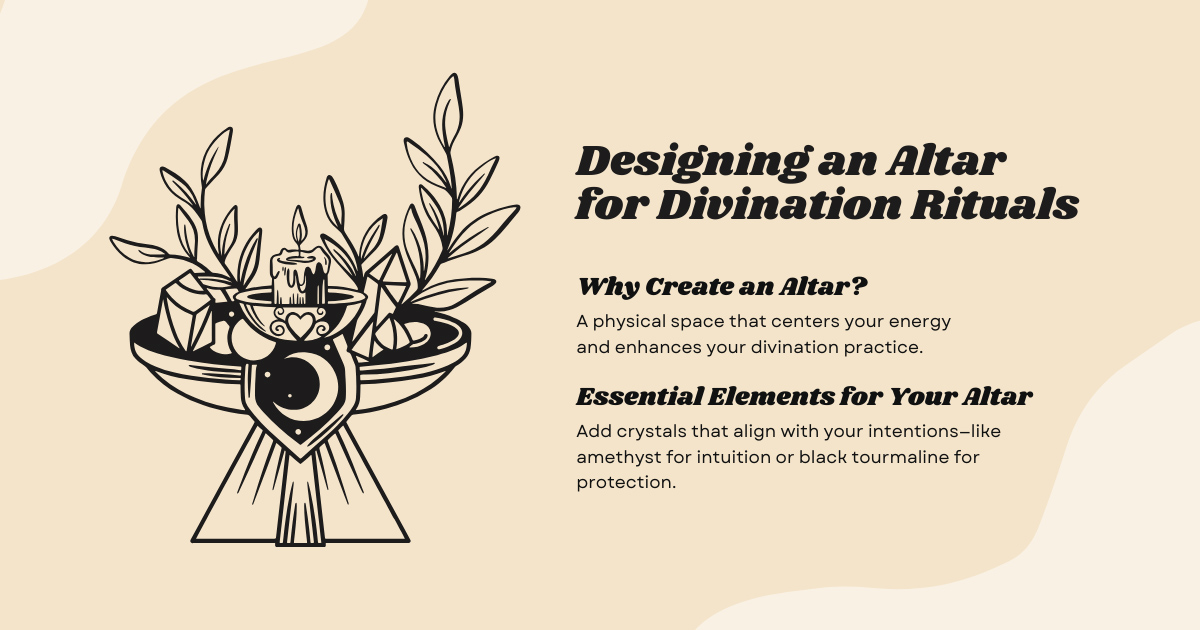
A sacred space is a cornerstone of spiritual practice, offering a dedicated area for reflection, intention-setting, and connection with your divination tools. Building an altar can deepen your rituals, creating a visually inspiring and energetically supportive environment.
Why Create an Altar?
An altar provides:
- Focus and Intention: A physical space that centers your energy and enhances your divination practice.
- Symbolic Connection: A representation of your spiritual journey and connection to higher energies.
- Personal Empowerment: A customized area that reflects your unique style and practice.
Choosing the Perfect Space
Your altar doesn’t need to be elaborate or take up much space. Choose an area where you feel comfortable and focused.
- Dedicated Area: A tabletop, shelf, or small corner is ideal.
- Portable Options: If space is limited, use a tray or box that can be easily stored and brought out during rituals.
- Privacy Matters: Select a spot where you can practice without interruptions.
Essential Elements for Your Altar
Design your altar with elements that enhance your divination rituals:
- Divination Tools: Include your tarot cards, runes, pendulum, or scrying tools.
- Candles: Light candles to set the mood and invite calm, focused energy.
- Crystals: Add crystals that align with your intentions—like amethyst for intuition or black tourmaline for protection.
- Sacred Objects: Include items that hold personal significance, such as heirlooms, photos, or small figurines.
- Natural Elements: Incorporate flowers, leaves, or water to ground your space and connect with nature.
- Incense or Essential Oils: Use calming scents like lavender or sandalwood to cleanse and elevate the energy.
Pro Tip: Choose colors and items that resonate with your practice. For example, deep blues and silvers are perfect for moon rituals, while greens and browns ground earthy energies.
Personalizing Your Space
Make your altar uniquely yours:
- Themes: Align your altar with the current season, moon phase, or your personal goals.
- Art and Imagery: Add visual inspiration with meaningful artwork, symbols, or affirmations.
- Lighting: Fairy lights or lanterns can add a magical, soft glow to your space.
Maintaining the Energy
Keep your altar energetically clear and vibrant:
- Cleansing Rituals: Regularly cleanse your space with sage, palo santo, or sound bowls.
- Refresh Elements: Swap out seasonal items or tools to keep the energy aligned with your current intentions.
- Organize: Keep the space tidy to allow energy to flow freely.
Using Your Altar
Once your altar is set, integrate it into your divination rituals:
- Morning or Evening Practice: Begin or end your day with a card pull, meditation, or journaling session at your altar.
- Moon Rituals: Use your altar for new moon intentions or full moon releases.
- Deep Dives: Spend time at your altar when performing in-depth readings or exploring complex questions.
Your altar is more than a physical space—it’s a sacred portal to your intuition and spiritual growth. By creating a space that feels personal and aligned with your energy, you’ll deepen your divination rituals and create a daily practice that nourishes your soul.
Embrace the Power of Divination
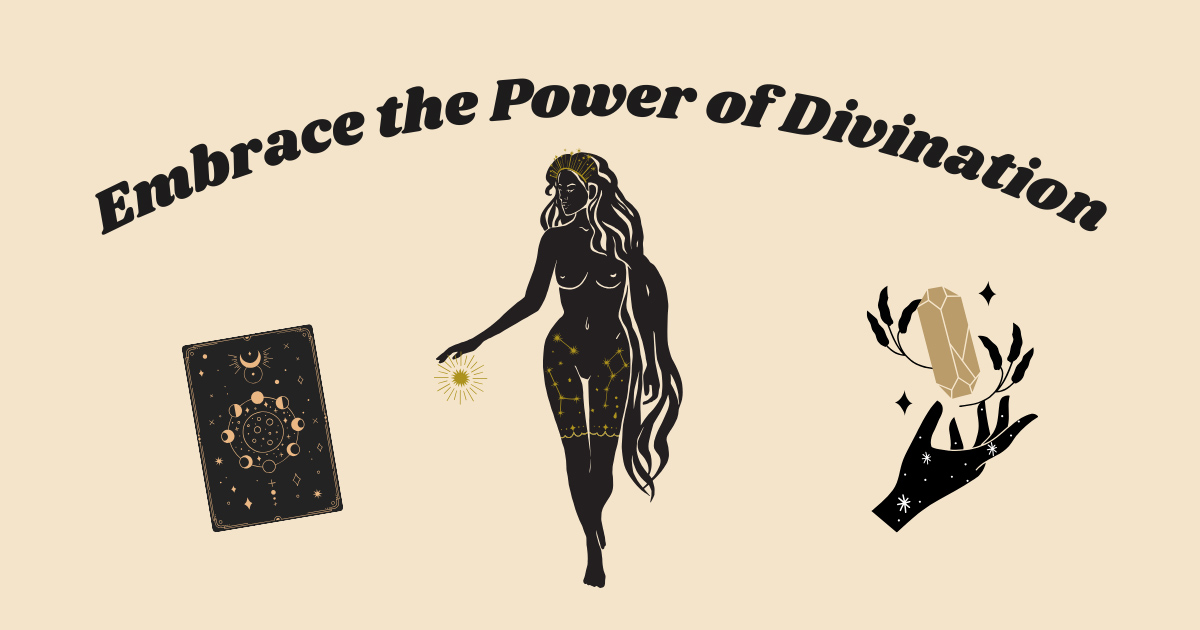
Divination tools are more than mystical objects—they’re gateways to self-discovery, spiritual connection, and empowerment. Whether you’re seeking clarity, guidance, or a deeper understanding of the universe, these tools invite you to explore the hidden layers of life with curiosity and intention.
From ancient traditions to modern practices, divination is a timeless way to navigate the mysteries of existence. You can weave their wisdom into your daily life by choosing tools that resonate with your energy, creating meaningful rituals, and embracing the insights they offer.
Let divination be your guide to unlocking intuition, embracing transformation, and finding clarity in the unknown. Your journey is as unique as the tools you choose to work with—and the universe is always ready to meet you halfway.
Sources:
Primary Source (University of Chicago PDF)
- Rochberg, F. (2004). The Heavenly Writing: Divination, Horoscopy, and Astronomy in Mesopotamian Culture. University of Chicago Press. Retrieved from https://isac.uchicago.edu/sites/default/files/uploads/shared/docs/saoc54_4th.pdf
Divination in Ancient Egypt
- Pinch, G. (2002). Magic in Ancient Egypt (Rev. ed.). University of Texas Press.
- Naydler, J. (1996). Temple of the Cosmos: The Ancient Egyptian Experience of the Sacred. Inner Traditions.
- Rochberg, F. (2004). The Heavenly Writing: Divination, Horoscopy, and Astronomy in Mesopotamian Culture. University of Chicago Press.
Chinese Divination & the I Ching
- Smith, R. J. (2008). Fortune-Tellers and Philosophers: Divination in Traditional Chinese Society. Princeton University Press.
- Lynn, R. T. (1994). The Classic of Changes: A New Translation of the I Ching as Interpreted by Wang Bi. Columbia University Press.
Nordic Runes & Divination
- Page, R. I. (1999). An Introduction to English Runes. Boydell Press.
- Pollington, S. (2016). Rudiments of Runelore. Anglo-Saxon Books.
Indigenous Divination Practices
- Tedlock, B. (2001). Time and the Highland Maya (Rev. ed.). University of New Mexico Press.
- Eliade, M. (1964). Shamanism: Archaic Techniques of Ecstasy. Princeton University Press.
Mesoamerican Divination & Cosmic Calendars
- Aveni, A. F. (2001). Skywatchers: A Revised and Updated Version of Skywatchers of Ancient Mexico. University of Texas Press.
- Tedlock, D. (1996). Popol Vuh: The Mayan Book of the Dawn of Life and the Glories of Gods and Kings. Simon & Schuster.
